- About us»
- Net income calculator»
- Population aging»
-
- Least developed regions»
-
- Average wage
- Material need benefits
- Meal allowance
- Counties of Slovakia
- Inflation
- Living and Subsistence Minimum
- Unemployment of Czechia and Slovakia
- NACE Classification
-
- Life expectancy
- Gender differences
- Youth unemployment and NEET
- Minimum wage in EU
- Unemployment rates of different age groups
- Share of salaries on GDP
- Percentage of employees ususally working at nights
- Employment rate
- Long term unemployment
- NEET
- Unemployment rate
-
- Bratislava and surroundings
- Kopanice
- Danube river
- lower Vah river
- middle Vár river
- upper Nitra river
- lower Nitra river
- Mining cities
- Kysuce a Orava
- upper Vah river - Liptov
- Spiš cities
- upper Hron river
- Juhoslovenská kotlina
- Košice fold and Torysa river
- upper Zemplín
- lower Zemplín
- EU regions
- NUTS3 regions of Slovakia
- LAU1 dataset
-
- Projects and activities
- Inclusive growth»
- Good work
- Project SKRS
- Social system – reality and vision
- Library
-
- Education of unemployed
- Young unemployed not taking part in education
- Proposal to change the system of education funding
- News»
- Contact
Nouvelle-Aquitaine – FRI
EU regions: France > Nouvelle-Aquitaine
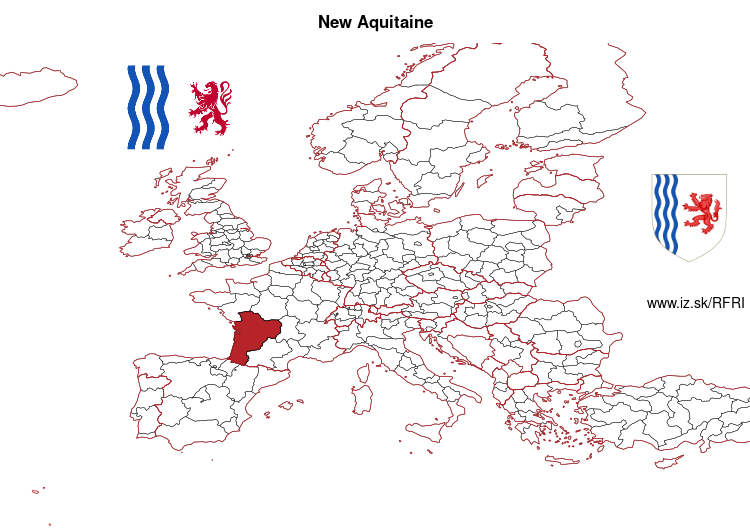
| Indicator | Period | Value |
|---|---|---|
| Life long learning | ||
| life long learning participation | 2024 | 16.2 |
| Part time jobs and flexible employment | ||
| percentage of part time workers | 2024 | 17.19 |
| percentage of part time workers, men | 2024 | 8.33 |
| percentage of part time workers, women | 2024 | 26.15 |
| Gender differences | ||
| gender gap in employment rate | 2024 | 93.52 |
| gender gap in unemployment rate | 2024 | 96.87 |
| Graduates and young people | ||
| unemployment rate of youth with elementary education | 2024 | 21.5 |
| NEET | 2024 | 9.4 |
| Gross domestic product | ||
| GDP per capita in PPS of EU average | 2023 | 84 |
| Employment | ||
| employment rate | 2024 | 71.6 |
More on wikipedia wikidata Q18678082 on OpenStreetMap Nouvelle-Aquitaine slovensky: FRI
Subregions: Aquitaine, Limousin, Poitou-Charentes
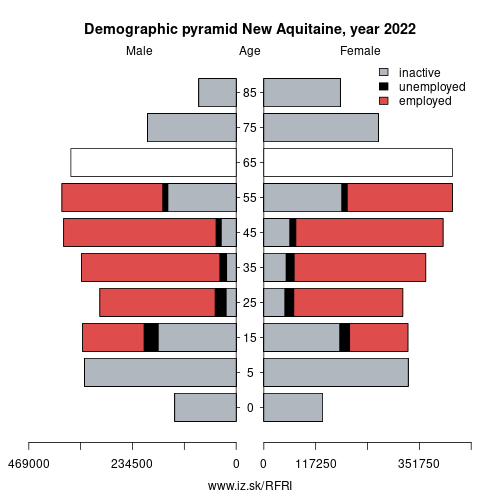
Unemployment
| Indicator | Period | Value |
|---|---|---|
| Unemployment | ||
| unemployment rate | 2024 | 6.4 |
| youth unemployment rate | 2024 | 16.2 |
| Long term unemployment | ||
| long term unemployment | 2024 | 1.1 |
| share of long term unemployed | 2024 | 18 |
Demographics
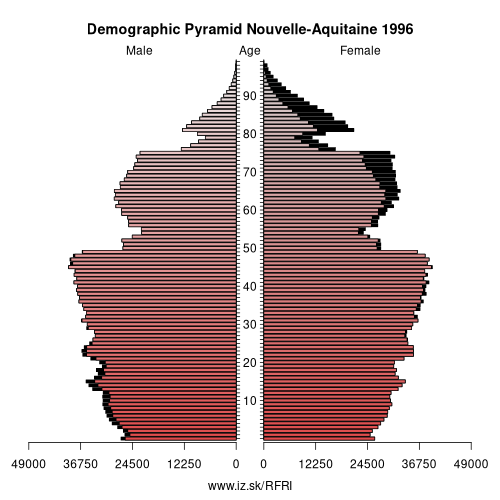
| Indicator | Period | Value |
|---|---|---|
| Demographics | ||
| number of inhabitants | 2024 | 6 166 602 |
| population density | 2023 | 73.1 |
| old-age dependency ratio | 2024 | 42.6 |
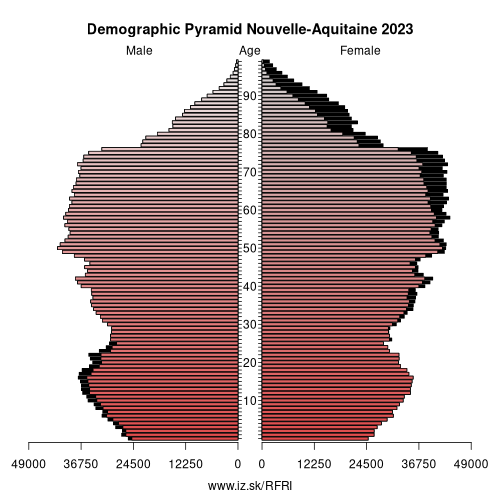
Employment by sectors, Nouvelle-Aquitaine
| NACE r2 | % | NACE r2 | % | ||
|---|---|---|---|---|---|
| A | 85.6 | 3% | B-E | 332 | 13% |
| F | 169 | 6% | G-I | 571.3 | 22% |
| J | 56 | 2% | K | 78.4 | 3% |
| L | 37.5 | 1% | M_N | 268.5 | 10% |
| NRP | 50.5 | 2% | O-Q | 830.5 | 32% |
| R-U | 147 | 6% | TOTAL | 2626.3 | 100% |
Data for the period year 2024. Source of the data is Eurostat, table [lfst_r_lfe2en2].
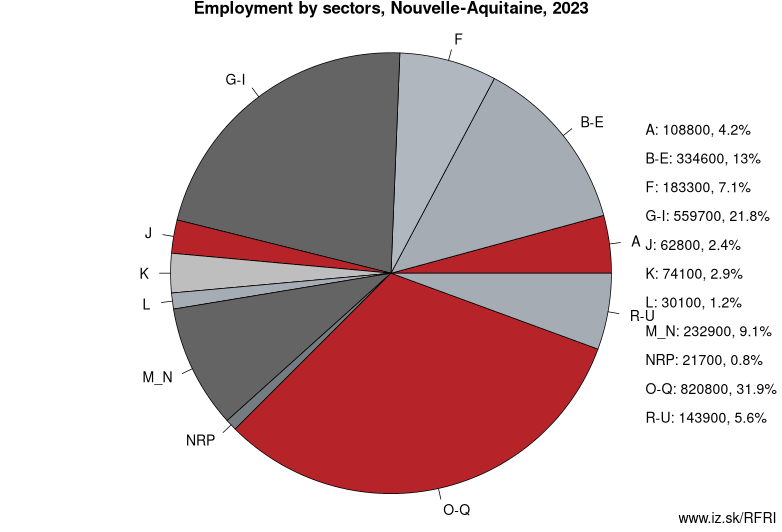
Nouvelle-Aquitaine (French: [nuvɛl akitɛn]; Occitan: Nòva Aquitània [ˈnɔβɔ akiˈtanjɔ] or Novèla Aquitània [nuˈβɛlɔ akiˈtanjɔ]; Basque: Akitania Berria; Poitevin-Saintongeais: Novéle-Aguiéne) or New Aquitaine, is the largest administrative region in France, spanning the west and southwest of the mainland. The region was created by the territorial reform of French Regions in 2014 through the merger of three regions: Aquitaine, Limousin and Poitou-Charentes. It covers 84,036 km2 (32,446 sq mi) – or 1⁄8 of the country – and has 5,956,978 inhabitants (municipal population on 1 January 2017). The new region was established on 1 January 2016, following the regional elections in December 2015.
It is the largest region in France by area, with a territory slightly larger than that of Austria; even French Guiana is smaller. Its largest city, Bordeaux, together with its suburbs and satellite cities, forms the 7th-largest metropolitan area of France, with 850,000 inhabitants. The region has 25 major urban areas, among which the most important after Bordeaux are Bayonne (288,000 inhabitants), Limoges (283,000), Poitiers (255,000), Pau (241,000), and La Rochelle (206,000), as well as 11 major clusters. The growth of its population, particularly marked on the coast, makes this one of the most attractive areas economically in France; the new region outperforms the Île-de-France and Provence-Alpes-Côte d'Azur in demographic dynamism.
After Île-de-France, New Aquitaine is the premier French region in research and innovation, with five universities (Bordeaux, La Rochelle, Limoges, Poitiers and Pau) and several Grandes Ecoles. The agricultural region of Europe with the greatest turnover, it is the French region with the most tourism jobs, as it has three of the four historic resorts on the French Atlantic coast: (Arcachon, Biarritz and Royan), as well as several ski resorts (e.g. Gourette), and is the fifth French region for business creation (all sectors).
Other: France, Auvergne-Rhône-Alpes, Normandy, Occitania, Nouvelle-Aquitaine, Hauts-de-France, Île-de-France, Pays de la Loire, overseas department and region of France, Bourgogne-Franche-Comté, Centre-Val de Loire, Grand Est, Brittany, Corsica, Provence-Alpes-Côte d'Azur
Neighbours: Occitania, Auvergne-Rhône-Alpes, Noreste, Pays de la Loire, Centre-Val de Loire
Subregions: Aquitaine, Limousin, Poitou-Charentes
Suggested citation: Michal Páleník: Europe and its regions in numbers - Nouvelle-Aquitaine – FRI, IZ Bratislava, retrieved from: https://www.iz.sk/PFRI, ISBN: 978-80-970204-9-1, DOI:10.5281/zenodo.10200164

 Share
Share Facebook
Facebook Twitter
Twitter News
News